An Appraisal of the MBS-10 Stereo Microscope
Robert R. Pavlis
Girard, Kansas USA 66743
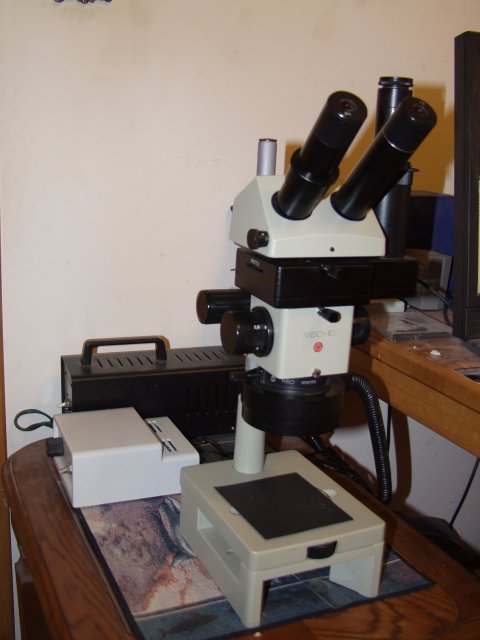 The Russian LOMO MBS-10 stereo microscopes are widely available around the world at prices far below those of most other stereo microscopes of similar quality. These instruments are also sometimes sold under other brand names and with other model designations such as SF-100. There are many accessories available. Prices for these accessories seem to be determined by a random number generator so that some of them are extraordinary bargains, whilst others are outrageously expensive.
The Russian LOMO MBS-10 stereo microscopes are widely available around the world at prices far below those of most other stereo microscopes of similar quality. These instruments are also sometimes sold under other brand names and with other model designations such as SF-100. There are many accessories available. Prices for these accessories seem to be determined by a random number generator so that some of them are extraordinary bargains, whilst others are outrageously expensive.
These microscope have an odd appearance. When one examines them closely one quickly comes to the conclusion that it is not just their appearance that is odd! They appear odd because they are! However, that does not necessarily mean that they are not great instruments. The optical qualities of these instruments are generally very high. Furthermore, the mechanical parts are quite rugged and the instrument is made from massive aluminium castings with practically no sheet metal parts. Different illumination systems and different stands are available making them fairly versatile.
I have owned and used one of these instruments for several years. About a year ago a friend gave me a second incomplete one, for which I have managed to locate all the required missing parts. It is now in perfect working order. The later instrument has a much larger serial number the first one I acquired, so is apparently much newer.
Optical design and body construction
Unlike many other stereo microscopes the MBS-10 does not utilise zoom lenses for objectives. Instead it has a very cleverly designed lens turret that provides five powers—0.6, 1.0, 2.0, 4.0, and 7.0 power. The same lenses are used for 0.6 and for 7.0 power, and the same lenses are used for 1.0 and 4.0. (In one position they provide the lower power, and rotated 180 degrees they provide the other.) The 2.0 power lens is symmetrical and provides the same power no matter which way it is rotated. The disadvantage of this clever system is that the powers do not change in an orderly manner when rotating the turret—the clockwise order is 0.6 4.0 2.0 7.0 1.0 2.0. The lens coatings on both instruments seem perfect. Resolution seems extraordinarily good at all powers except at 0.6X. Both instruments show poor image qualities at the edge of the field at this power only. Although many people regard the lack of a zoom objective system as a negative, it is a strong positive when the microscope is being used for measuring objects with oculars with reticules. (vide infra). This fact makes this a particularly good instrument for precision measurement.
The lens turret is machined quite well, it rotates smoothly, and clicks into place at the various powers with no slackness. Note that it is machined rather than cast. The lenses are mounted in the turret with good precision. The lenses have fairly good parfocality.
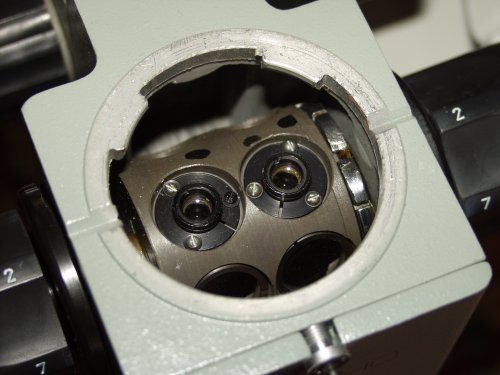 The focusing knobs and lens turret knobs are made of plastic, and not very good plastic at that. Plastic is generally a VERY poor construction material for microscopes. The design of these knobs is such that aluminium or brass replacements could easily be machined to replace them, but the microscope should have had better ones in the first place to make this unnecessary.
The focusing knobs and lens turret knobs are made of plastic, and not very good plastic at that. Plastic is generally a VERY poor construction material for microscopes. The design of these knobs is such that aluminium or brass replacements could easily be machined to replace them, but the microscope should have had better ones in the first place to make this unnecessary.
The prism system that sends the image to the oculars seems excellent. The oculars have first rate coatings, and have reasonably wide fields. Unfortunately they are NOT the standard 30mm diameter used for stereo microscopes in the rest of the world. Their diameter is rather close to the standard diameter used for telescopes, however. (Adaptors can easily be machined to utilise either standard 23.3mm or 30mm oculars.) The instrument is sold complete with 8X and 14X oculars. The field number for the 8X oculars is 23mm, and for the 14X it is 16mm. An extra 8X ocular is provided with two interchangeable calibrated reticules. This ocular has provision for focusing the reticule. It works best with the photo attachment, described next. Unlike almost all other microscopes the interocular distance is adjusted by turning a knob rather than by pushing or pulling the lens tubes. This is a very good design, actually. Anyone considering packing one of these instruments for shipment should probably consider removing the ocular tubes from the head. They can be removed by simply unscrewing them. The quality of construction of the head on my original instrument is quite a bit better than the newer one.
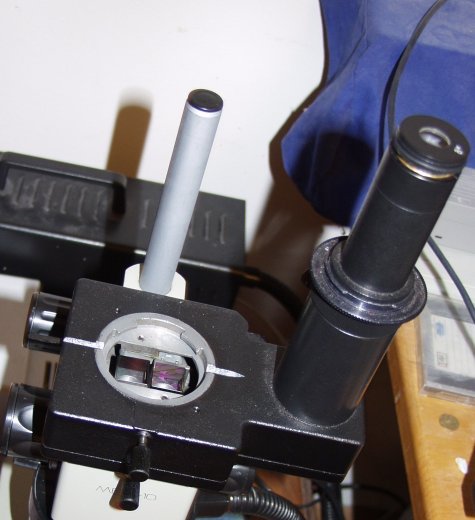 The original instrument is equipped with the photo attachment. This is an odd device that fits between the body of the microscope and the head. One can place reticule eyepieces on it and use it for measuring. One can also, of course, use it for photography! It is designed to allow Zenit and Praktica cameras to connect directly to it. One can find with some searching an inexpensive adaptor to allow Nikon 35mm cameras to be attached too. I machined an adaptor to allow connecting digital cameras via eyepieces, this works very well. The quality of this accessory is quite high.
The original instrument is equipped with the photo attachment. This is an odd device that fits between the body of the microscope and the head. One can place reticule eyepieces on it and use it for measuring. One can also, of course, use it for photography! It is designed to allow Zenit and Praktica cameras to connect directly to it. One can find with some searching an inexpensive adaptor to allow Nikon 35mm cameras to be attached too. I machined an adaptor to allow connecting digital cameras via eyepieces, this works very well. The quality of this accessory is quite high.
Stands
There are at least three types of stands in use for these microscopes. The standard one is a rugged aluminium casting with a very rigid vertical steel rod that holds the microscope body. There is a special movable ring that one can use to prevent accidentally driving the objectives into specimens. The base is designed so that the standard light source can be fit into it to provide sub stage illumination. Most users seem to have little use of this feature. Also the stage has a glass disk to use with sub stage illumination, and a solid metal one, painted white one one side and black on the other for use when the sub stage illuminator is not used. The base is in two sections, with the lower section carrying the sub stage illuminator. The lower illuminator portion of it can be removed. There is also a set of plastic arm rests that fit into the side of the base. The standard stand is really rather well engineered. It uses heavy castings and is extremely robust.
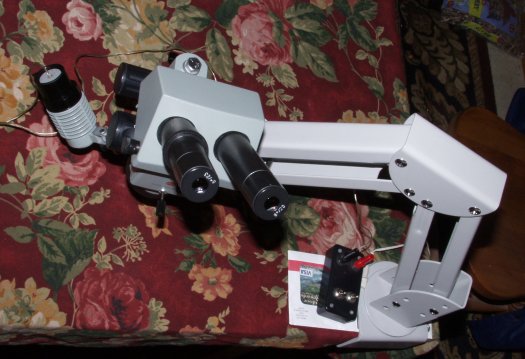 The second MBS-10 that my friend gave me did not have a stand at all. I managed to find one of the special cantilever stands that attaches to a table. This device is very useful for examining things like stamps, coins, mineral specimens when one wants to study a large area by moving the microscope rather than the subject. I obtained this stand new, and in spite of that it had two amazing manufacturing defects that I did not notice immediately, but that required attention very quickly: (1) The adjusting knob that is used to secure the stand to a table was equipped with a
3/8" ASA coarse thread. The hole into which it fit was originally drilled for a
10mm thread, but tapped with 3/8". 3/8" is most definitely NOT 10mm! A few weeks after I got the stand the thread stripped. I simply made a brass knob and a circular plate to press against the underside of the table and attached them to a 10mm threaded rod. I re-tapped the hole with a 10mm tap, and installed the replacement. (2). The adjusting knob that is used to adjust the angle of the microscope head also had 3/8" threads when the hole for it was drilled for 10mm. This required the same solution used for the clamping knob. Until this repair was made, the knob was loose and constantly out of adjustment. This repair completely solved the problem. However it is annoying that the manufacturers had this poor quality control.
The second MBS-10 that my friend gave me did not have a stand at all. I managed to find one of the special cantilever stands that attaches to a table. This device is very useful for examining things like stamps, coins, mineral specimens when one wants to study a large area by moving the microscope rather than the subject. I obtained this stand new, and in spite of that it had two amazing manufacturing defects that I did not notice immediately, but that required attention very quickly: (1) The adjusting knob that is used to secure the stand to a table was equipped with a
3/8" ASA coarse thread. The hole into which it fit was originally drilled for a
10mm thread, but tapped with 3/8". 3/8" is most definitely NOT 10mm! A few weeks after I got the stand the thread stripped. I simply made a brass knob and a circular plate to press against the underside of the table and attached them to a 10mm threaded rod. I re-tapped the hole with a 10mm tap, and installed the replacement. (2). The adjusting knob that is used to adjust the angle of the microscope head also had 3/8" threads when the hole for it was drilled for 10mm. This required the same solution used for the clamping knob. Until this repair was made, the knob was loose and constantly out of adjustment. This repair completely solved the problem. However it is annoying that the manufacturers had this poor quality control.
If one examines web pages on the MBS-10, one will find that recently a third type of stand has become available for these instruments. It also has a clamp to fasten it to rigid tables. It is simply a rigid column that permits the microscope to swing about a centre. It is obviously inferior to the cantilever design that permits moving the microscope all over a wide area.
Illuminators
These instruments come equipped with a strange cast aluminium light source that holds one of the miserably poor quality Russian 9V tungsten filament bulbs. (These light sources are sold separately for truly outrageous prices.) This device can be improved dramatically by replacing the Russian 9V tungsten filament bulb with a white LED. Click here for information on one way to do this. A standard 3 watt white LEDs provide a rather uniform square illuminated source that projects very well through the lens system of the original MBS-10 illuminator to produce a square illuminated area of nearly the ideal size! The microscope with the cantilever mount is so equipped.
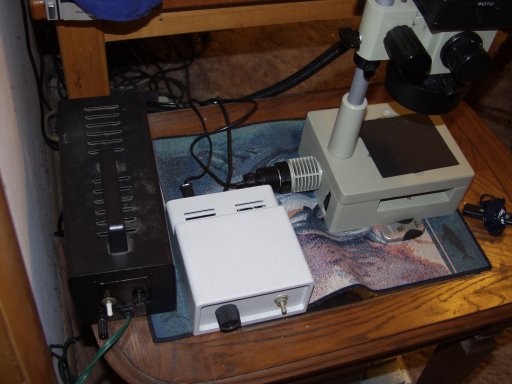 There is available a rather expensive fibre optic illuminator. It typically is sold for about the same price as the entire microscope. I have one of these. The illuminator attaches directly to the body of the microscope below the objectives. Its mechanical construction leaves a bit to be desired. It has a plastic body, which automatically means that it is inferior. It would be probably fairly easy to make a replacement metal body for it with a lathe. The illumination angle is supposed to be adjustable by turning the illuminator body, but this does not work well, it is hard to turn. The fibre optics, however, do deliver very high quality even illumination to the subject.
There is available a rather expensive fibre optic illuminator. It typically is sold for about the same price as the entire microscope. I have one of these. The illuminator attaches directly to the body of the microscope below the objectives. Its mechanical construction leaves a bit to be desired. It has a plastic body, which automatically means that it is inferior. It would be probably fairly easy to make a replacement metal body for it with a lathe. The illumination angle is supposed to be adjustable by turning the illuminator body, but this does not work well, it is hard to turn. The fibre optics, however, do deliver very high quality even illumination to the subject.
The light was originally provided by a 9V Russian halogen bulb. These bulbs were of poor quality, and the two that I had quickly burned out. Instead of wires, string wrapped with copper foil was used as electrical conductors! One had to disassemble the light source constantly to reattach the wires to lamp as they often came loose. One day one of my students and I took everything out of it and discarded it all—even the fuse holder and switch—everything. We replaced everything! There is a common Phillips 12V bulb that is exactly the same size as the original 9V Russian one. We installed one of these. We got rid of the 9V transformer and replaced it with a 12V one. It has worked perfectly since then.
There are third party LED illuminators available for stereomicroscopes now. These are much less expensive than the MBS-10 fibre optic illuminator, and probably would not require repairs before being useable.
Again, with the aid of a lathe one could also machine a LED holder from aluminium stock, an set it up to hold either four or six LEDs.
General Comments
The MBS-10 has rather good optics. Images are sharp and fairly flat at all powers with practically no colour fringing, except using the 0.6X objective setup only provides a good image at the centre of the field with the 8X objective.
It is made utilising massive solid castings, giving it a robust look. The design of the instrument is very different than other stereo microscopes giving it an unusual, even odd, appearance. Being different does NOT make it bad.
Although general quality of construction is rather high, some parts, especially accessories, can be of extraordinarily low quality. Particularly glaring examples of poor construction include the use of plastic in the focusing and lens turret adjusting knobs, the use of 3/8 inch adjusting knobs in holes drilled for 10mm on the cantilever stand, the inappropriate use of plastic in the fibre optic illuminator housing, and the use of wretched Russian electrical parts everywhere.
The standard illuminator does not provide very even illumination, but it can be modified fairly easily to utilise modern high wattage LEDs. This modification provides a rather even and highly acceptable light source.
The fibre optic accessory available for this instrument provides even illumination, but the outside body of this illuminator is made of plastic. For the price of this accessory one should expect the use of better materials.
Fortunately most (if not all) of the poorly constructed parts can be replaced fairly easily. Replacing electrical parts is particularly easy and inexpensive. Replacing other parts like the 3/8 inch adjusting knob and clamp knob is simple to accomplish, but it can still be an annoyance.
One really should not have to spend time repairing new instruments! However, the optical quality of these instruments coupled with their low price seems to be a small price to pay for a bit of inconvenience. However, I suspect most purchasers of these instruments would rather spend perhaps 10% more and have an instrument that would not require repair before first use!
In spite of the shortcomings mentioned above, these microscopes really are research quality instruments. Their construction is robust—robust enough so that they should be able to remain in service for decades and decades. The plastic focusing and objective turret knobs might not last for too many years, but should they fail new ones could be fabricated easily.
All comments to the
author
Robert
Pavlis
are
welcomed.
Microscopy UK Front Page
Micscape Magazine
Article
Library
© Microscopy UK or their
contributors.
Published in the March 2006 edition
of Micscape
Magazine.
Please report any Web problems or
offer general comments to the
Micscape
Editor
.
Micscape is the on-line monthly
magazine of the Microscopy UK website at
Microscopy-UK
© Onview.net Ltd, Microscopy-UK, and
all contributors 1995 onwards. All rights reserved. Main site
is at
www.microscopy-uk.org.uk
with full
mirror at
www.microscopy-uk.net
.
 The focusing knobs and lens turret knobs are made of plastic, and not very good plastic at that. Plastic is generally a VERY poor construction material for microscopes. The design of these knobs is such that aluminium or brass replacements could easily be machined to replace them, but the microscope should have had better ones in the first place to make this unnecessary.
The focusing knobs and lens turret knobs are made of plastic, and not very good plastic at that. Plastic is generally a VERY poor construction material for microscopes. The design of these knobs is such that aluminium or brass replacements could easily be machined to replace them, but the microscope should have had better ones in the first place to make this unnecessary.
 The Russian LOMO MBS-10 stereo microscopes are widely available around the world at prices far below those of most other stereo microscopes of similar quality. These instruments are also sometimes sold under other brand names and with other model designations such as SF-100. There are many accessories available. Prices for these accessories seem to be determined by a random number generator so that some of them are extraordinary bargains, whilst others are outrageously expensive.
The Russian LOMO MBS-10 stereo microscopes are widely available around the world at prices far below those of most other stereo microscopes of similar quality. These instruments are also sometimes sold under other brand names and with other model designations such as SF-100. There are many accessories available. Prices for these accessories seem to be determined by a random number generator so that some of them are extraordinary bargains, whilst others are outrageously expensive.
 The original instrument is equipped with the photo attachment. This is an odd device that fits between the body of the microscope and the head. One can place reticule eyepieces on it and use it for measuring. One can also, of course, use it for photography! It is designed to allow Zenit and Praktica cameras to connect directly to it. One can find with some searching an inexpensive adaptor to allow Nikon 35mm cameras to be attached too. I machined an adaptor to allow connecting digital cameras via eyepieces, this works very well. The quality of this accessory is quite high.
The original instrument is equipped with the photo attachment. This is an odd device that fits between the body of the microscope and the head. One can place reticule eyepieces on it and use it for measuring. One can also, of course, use it for photography! It is designed to allow Zenit and Praktica cameras to connect directly to it. One can find with some searching an inexpensive adaptor to allow Nikon 35mm cameras to be attached too. I machined an adaptor to allow connecting digital cameras via eyepieces, this works very well. The quality of this accessory is quite high.
 The second MBS-10 that my friend gave me did not have a stand at all. I managed to find one of the special cantilever stands that attaches to a table. This device is very useful for examining things like stamps, coins, mineral specimens when one wants to study a large area by moving the microscope rather than the subject. I obtained this stand new, and in spite of that it had two amazing manufacturing defects that I did not notice immediately, but that required attention very quickly: (1) The adjusting knob that is used to secure the stand to a table was equipped with a
3/8" ASA coarse thread. The hole into which it fit was originally drilled for a
10mm thread, but tapped with 3/8". 3/8" is most definitely NOT 10mm! A few weeks after I got the stand the thread stripped. I simply made a brass knob and a circular plate to press against the underside of the table and attached them to a 10mm threaded rod. I re-tapped the hole with a 10mm tap, and installed the replacement. (2). The adjusting knob that is used to adjust the angle of the microscope head also had 3/8" threads when the hole for it was drilled for 10mm. This required the same solution used for the clamping knob. Until this repair was made, the knob was loose and constantly out of adjustment. This repair completely solved the problem. However it is annoying that the manufacturers had this poor quality control.
The second MBS-10 that my friend gave me did not have a stand at all. I managed to find one of the special cantilever stands that attaches to a table. This device is very useful for examining things like stamps, coins, mineral specimens when one wants to study a large area by moving the microscope rather than the subject. I obtained this stand new, and in spite of that it had two amazing manufacturing defects that I did not notice immediately, but that required attention very quickly: (1) The adjusting knob that is used to secure the stand to a table was equipped with a
3/8" ASA coarse thread. The hole into which it fit was originally drilled for a
10mm thread, but tapped with 3/8". 3/8" is most definitely NOT 10mm! A few weeks after I got the stand the thread stripped. I simply made a brass knob and a circular plate to press against the underside of the table and attached them to a 10mm threaded rod. I re-tapped the hole with a 10mm tap, and installed the replacement. (2). The adjusting knob that is used to adjust the angle of the microscope head also had 3/8" threads when the hole for it was drilled for 10mm. This required the same solution used for the clamping knob. Until this repair was made, the knob was loose and constantly out of adjustment. This repair completely solved the problem. However it is annoying that the manufacturers had this poor quality control.
 There is available a rather expensive fibre optic illuminator. It typically is sold for about the same price as the entire microscope. I have one of these. The illuminator attaches directly to the body of the microscope below the objectives. Its mechanical construction leaves a bit to be desired. It has a plastic body, which automatically means that it is inferior. It would be probably fairly easy to make a replacement metal body for it with a lathe. The illumination angle is supposed to be adjustable by turning the illuminator body, but this does not work well, it is hard to turn. The fibre optics, however, do deliver very high quality even illumination to the subject.
There is available a rather expensive fibre optic illuminator. It typically is sold for about the same price as the entire microscope. I have one of these. The illuminator attaches directly to the body of the microscope below the objectives. Its mechanical construction leaves a bit to be desired. It has a plastic body, which automatically means that it is inferior. It would be probably fairly easy to make a replacement metal body for it with a lathe. The illumination angle is supposed to be adjustable by turning the illuminator body, but this does not work well, it is hard to turn. The fibre optics, however, do deliver very high quality even illumination to the subject.